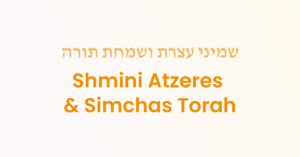We have just concluded the most intense period of the year, beginning with Elul and concluding with Yom Kippur. We have hopefully tried our best to do teshuva and come out with a fresh, clean slate for the new year!
Now we are going back to “regular” life, without the pressure of the Yamim Nora’im reminding us to be extra careful with our mitzvos. But as we return to our “regular” life, how can we maintain the inspiration and sense of closeness to Hashem that we worked so hard to achieve in the past month?
We actually don’t need to look too far…. the answer is hidden in the message of Sukkos, which is just a few days away!
Sukkos: Elevating Our Regular Activities
As the Gemara teaches, the main concept behind Sukkah is “Teishvu K’ein Taduru – Live in the Sukkah just as you would live in your house.”1 For 7 days, we take our normal everyday activities – eating, drinking, and sleeping – and we move it all into the Sukkah. Whatever we normally do in our houses, we now do in the Sukkah.
Why does Hashem ask us to do this? Why move into a small hut outside?
The Sifsei Chaim2 explains that Hashem wants to give us a special opportunity: For these 7 days, just by being in the Sukkah, we can transform our everyday activities into mitzvos.
For these 7 days, just by being in the Sukkah, we can transform our everyday activities into mitzvos.
We’ll need to eat anyway, so Hashem commands: “Go outside and eat in the Sukkah, so now your eating will be a mitzvah.” We need to sleep anyway, so Hashem says: “Go outside and sleep in the Sukkah, so your sleeping will be a mitzvah.” Every moment that we spend in the Sukkah is a mitzvah, even if we aren’t doing anything special.
This unique opportunity lasts for only 7 days, but this lesson is meant to stay with us throughout the whole year: Sukkos teaches us that any mundane activity can be transformed into a mitzvah, if we just infuse our actions with the proper focus and intentions. On Sukkos, Hashem gives us a gift that our eating and sleeping is considered a mitzvah just by virtue of the fact that we are doing it in the Sukkah, as Hashem commanded.
But even during the rest of the year, we can still elevate our mundane actions into mitzvos by simply infusing them with elevated intentions:
But even during the rest of the year, we can still elevate our mundane actions into mitzvos by simply infusing them with elevated intentions:
When we go to sleep, if we think, “I am going to sleep so that I will wake up in the morning refreshed, with more energy to serve Hashem,” then our sleeping becomes a mitzvah. If we eat breakfast with the thought, “I am eating so that I’ll have energy to serve my Creator,” then our eating becomes a mitzvah. If we go to work with the thought, “I am working so that I’ll have money to buy food l’kavod Shabbos,” then working at our job becomes a mitzvah. No matter what we are doing, we can always transform our activities into mitzvos if we just focus on how we are using them to serve Hashem.
This is also the message hidden in the mitzvah of Lulav. The Sefer HaChinuch3 writes that each of the 4 species represents a different limb in a person’s body: The Esrog is shaped like a heart, to symbolize that we should use our hearts and minds to serve Hashem. The Lulav is shaped like a spine to hint that we should use our entire body to serve Hashem. The Hadassim are shaped like eyes, to hint that we should be careful not to see inappropriate things with our eyes. And finally, the Aravos are shaped like lips to remind us to be careful with our speech.
When we shake the lulav, each of the 4 species reminds us to use every limb in our body for serving Hashem!
When we shake the lulav, each of the 4 species reminds us to use every limb in our body for serving Hashem!
The Simcha of Sukkos
Perhaps we can now understand why Sukkos is called “Zman Simchaseinu – The Holiday of Our Joy.” Why are we more happy on Sukkos than on any other holiday?
As we explained earlier, happiness comes from acquisitions. We feel happy when we realize that we have acquired something great – whether it’s finding a $20 bill lying on the ground, buying a new outfit, or landing a new job.
Happiness comes from acquisitions.
On a basic level, Sukkos is a time of joy because it happens in the Fall, at the end of the harvest season (hence the name “Chag Ha’Asif”). Imagine a farmer who has worked so hard throughout the whole year to plant and carefully tend to his crops. Finally, now, at the end of the harvest season, he is able to gather in his crops and take stock of what he has. He looks at all his new crops and exclaims, “Wow! Look at how much I have acquired!” Since Sukkos happens at the end of the harvest season, it is a time of great joy for all the farmers because they’re so happy about all the crops they have acquired.
But if we are looking for a deep, everlasting sense of happiness, the deepest happiness comes from acquiring something that is eternal. Yes, the crops are great, but soon they will be turned into food that will be eaten and finished. The surprise $20 bill is great, but soon it will be used to pay your bills, and you’ll never think about it again.
The deepest happiness comes from acquiring something that is eternal.
So what kind of acquisitions can bring us happiness that will really last forever?
The answer is that the only way to earn eternal happiness is by doing mitzvos. The pleasure that we acquire from eating a slice of pizza, buying new house, or getting a new car will all eventually fade away, but mitzvos last forever. Every time we do a mitzvah, we earn eternal reward in Olam Haba. Our bodies, our money, and our physical possessions will all fade away when we pass on to the Next World. The only thing we can bring with us into the next world is our mitzvos and our connection to Hashem.
The only way to earn eternal happiness is by doing mitzvos.
We can now understand why Sukkos is the time of ultimate happiness. As we explained above, Sukkos teaches us that we can transform every moment of our lives into a mitzvah, simply by having the proper focus.
Just as the Sukkah transforms our regular eating and sleeping into mitzvos that will earn eternal merit, so too, any time that we eat or sleep with elevated intentions, we can earn eternal reward. Realizing this hidden potential in our lives – that any minute can be transformed into an everlasting mitzvah – is what brings us such a tremendous sense of joy.
Realizing this hidden potential in our lives – that any minute can be transformed into an everlasting mitzvah – is what brings us such a tremendous sense of joy.
The intense joy of Sukkos is the realization that, “Wow! All day long I have so many opportunities to earn eternal reward and closeness to Hashem!”
So in the next week or so, as we build, decorate, and live in our Sukkahs, let’s remember that we can transform every moment of our lives into an everlasting mitzvah. All it takes is a little thought and focus. Connecting to Hashem through our everyday activities will help us maintain the awareness and closeness to Hashem that we worked so hard to achieve during the Yamim Nora’im.
Sources: [1] Sukkah 28b; [2] Sifsei Chaim Middos V’Avodas Hashem Vol. I. pg. 489; [3] Sefer HaChinuch Mitzvah #324. // For a more in-depth explanation of the connection between Sukkos and happiness, see Rabbi Lawrence Keleman’s audio shiur entitled Holidays – Preparing for Succot: The Secret of Happiness.
Your Challenge
Before you do a regular mundane activity, think about how it is helping you serve Hashem.
FOR EXAMPLE:
- I am going to sleep so that I’ll wake up refreshed and energized to daven Shacharis in the morning.
- I am eating lunch now so that I’ll have energy to take care of my kids later today / to learn Torah this afternoon.
- I am getting dressed so that I can look nice l’kavod Shabbos.
- I am cleaning my house because it is a chessed that I can do for the rest of my family – making sure that we live in a clean, pleasant environment.



